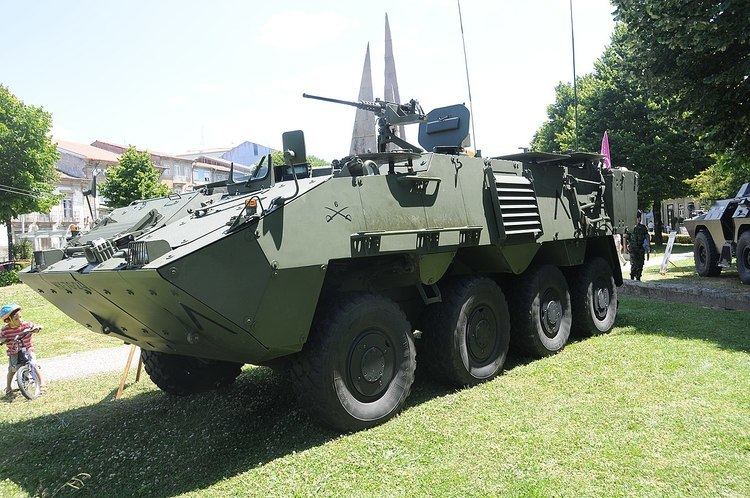 | ||
In 2005 the Portuguese government signed a deal worth 364 million euros to acquire 260 Pandur II armoured vehicle, with an option for further 33 worth 140 million euros, to equip the Portuguese Intervention Brigade of the Portuguese Army and the marines of the Portuguese Navy. Portugal was the first country to buy Pandur II. The sale of Pandur II to Portugal includes an associated offset agreement for a value of 516 million euro. The methodology of the selection process was officially based on four main characteristics of the bidder´s offers: 1) cost; 2) technical requirements; 3) offset proposal; 4) delivery schedule.
Contents
The first 41 Pandur II were manufactured in Austria, the further 219 are being manufactured by Fabrequipa in Portugal.
Timeline
Variants of Pandur II
The Pandur II for the marine will be amphibious and have a cargo ramp instead of the original doors.
Armour
The Pandur II for the Portuguese Army is fitted with Steyr add-on armour that provides Level 4 protection according to STANAG 4569. The vehicles for the marines are equipped with Level 3 armour. However, Portuguese army did not accept the quality of the Pandur II and keep only 120 Pandurs in Portugal a título provisório, that means that either Pandur II are not technically suitable or some other part of the contract with General Dynamics was not fulfilled, or both.
Offset issues
It is worthy to return to the surprising and preemptive exclusion of Patria. It could not have been on technical problems, since Patria AMV was a vehicle more tested than Pandur. Before Portugal´s purchase there were only few prototypes of Pandur II. On the other hand, Patria sold AMV to many countries: Finland, Poland, Croatia, Sweden, United Arab Emirates, South Africa, Slovenia. The exclusion of Patria AMV put Portugal in the awkward condition to have to negotiate with one supplier only. Portugal moved from a situation of monopsony (only one buyer and many sellers -typical of arms procurement) to a situation of monopoly (only one seller). It has been stated that Patria proposed the only vehicle that did not show the requested operational capabilities. The fact that the company gave its price offer after the deadline, knowing that this might have disqualified Patria from the tender, was also interpreted as a desire to avoid the final tests with the Portuguese Military, since the results could have harmed Patria's international image. However. this interpretation of Patria´s intentions is not consistent with Patria´s successive actions, especially with Patria´s public legal appeal against the decision of the Ministry of Defense. If a company wants to go unnoticed, it does not make such a public statement against the Portuguese real motivations for the elimination of Patria.
After the elimination of Patria in 2004, Portugal was effectively left with one competitor, that is, General Dynamics Pandur vs.General Dynamics Piranha, GD vs. GD. At this point, the only factor that had actual weight for the Ministry of Defense was the offset proposal. Most of the serious problems on Pandur procurement pertain to the offset package offered by General Dynamics. Patria had claimed it was unrealistic, and time has shown that Patria was right. They claimed also that General Dynamics offset package was intentionally misleading, and this was an understatement. Fabrequipa, direct offset, is the most known case. General Dynamics transferred the Pandur production to Czech Republic, blaming the global economic crisis for their breach of the Pandur offset contract. The case of Tecnia Lda of Torres Vedras is connected to an indirect offset, that General Dynamics based in a LGT branch in Luxembourg. It was supposed to support Portuguese environmental and water technologies sales in Saudi Arabia and it is the most embarrassing of all Portuguese contractual violations related to the offset program. The destruction of Tecnia to justify the issuing offset certificates exposes the ways General Dynamics conceives offset contracts and offset fulfillment in Europe. The problem of the weight of offset in the procurement decisions is not exclusively Portuguese. It is a European plague. In the European horizon one can understand what happened in the Pandur procurement between 2003 and 2005 by looking at the Slovenian case, that is one of the many battles in the commercial war between Patria and General Dynamics European Land Systems. In 2008 Jorma Wiitakorpi (Patria CEO) was arrested in Finland and charged with bribery and industrial espionage. Portuguese Pandur offset agreement demonstrates the urgency of a European reform to enforce Lisbon Treaty article 346, and the European convention against corruption involving officials.
